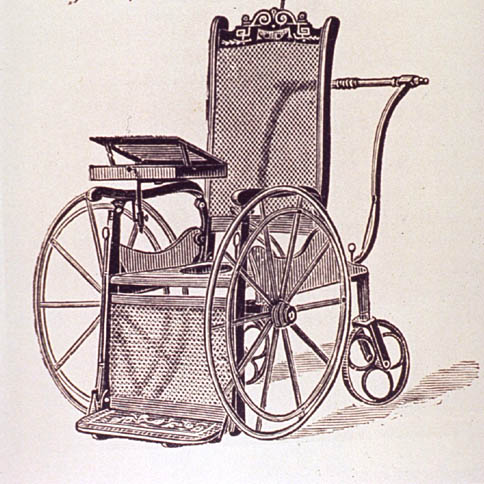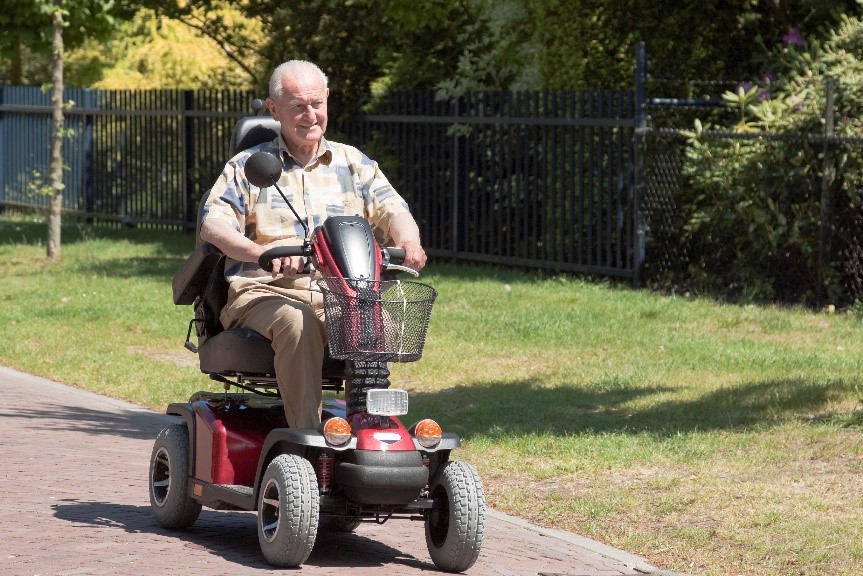The History of Personal Mobility Devices
The development of personal mobility devices been slow, and there’s still a long way to go for truly universal access
Written by stannah

There is still a long way to go for truly universal access.
Personal mobility devices have been used for centuries by people experiencing reduced mobility. Their benefit to society is invaluable and of utmost importance!
However, the path towards the development of personal mobility devices has not been an easy one and there’s still a long way to go for truly universal access.
Therefore, it is important that we raise awareness and work towards living in a more inclusive society, where access to all buildings would not only be a universal right, but also a reality.
History shows us that the evolution of universal access has seen many ups and downs, but despite all the changes and increased awareness, progress remains slow.
Let’s have a brief look at the history of personal mobility devices!
- What is a personal mobility device?
- The Evolution of an awareness of people with reduced mobility
- Brief History of Personal Mobility Device
What is a personal mobility device?
The most common personal mobility devices are typical walkers and walking sticks, used since time immemorial, as well as wheelchairs, which have evolved more significantly in recent decades. But there are many more, some of which have even been used for centuries.
It was only in the second half of the 20th century that true awareness regarding the need to adapt physical environments to people’s needs appeared. Thus arose, little by little, the concept of the elimination or removal of barriers through the construction of ramps and lifts for easy access to buildings or to upper floors.

The walking stick has been used by elders since time immemorial
But the greatest turning point in the history of reduced mobility was in the year 1974, at the “United Nations Expert Group Meeting on Barrier Free Design”, held in New York. It was the official acknowledgement that the removal of physical barriers had to happen, so that people with reduced mobility could fully participate in all aspects of social life, on equal terms. It also established the need for educating architects, engineers, urban planners and landscape artists on universal access.
The evolution of an awareness of people with reduced mobility

Barriers that prevent universal access are everywhere.
If we look back to the Middle Ages, society did not feel any responsibility for people with reduced mobility or disabilities. So, there was little progress at that time. In addition, many of these people lived as outcasts in a society full of superstitions.
In the 15th century, Queen Elizabeth of Spain created the first hospital where soldiers were provided with prosthetic and therapeutic devices. They also received pensions. During her reign, institutions for children, blind, deaf and disabled people were also created.
In the 18th century – under the influence of Voltaire and Rousseau – there was a change in attitudes towards disabled people, based on a mindset shift. Gradually, society started to look at life and the world as the basis of human experience.
Simultaneously, with the arrival of the Industrial Revolution, people with disabilities or reduced mobility begin to form part of a public responsibility.
Later, in the 19th century, with the development of medicine, scientists begin the study of the causes of disability.
Finally, in the 20th century, this change of attitude towards reduced mobility and disability changes more dramatically, due to the following factors:
- Advances in science
- A better educated society with empathy towards people with disabilities
- The evolution of the industrial and capitalist society
- Due to lack of manpower, during the world wars and global conflicts even people with physical limitations were required to work in factories and government instututions
- Social movements
- Emergence of physical therapy as a medical specialty
Now join us on this journey through the history of personal mobility devices. We have much more to tell you!
A Brief History of Personal Mobility Devices
The evolution of personal mobility devices is very much linked with the evolution of an awareness of people with reduced mobility.
The evolution of the wheelchair

This a drawing by an unknown Chinese artist. It features in the first page of the “Xiao er lun”, where Confucius (551? B.C-478? B.C) has a dialogue with a child while he is sitting in a wheelchair. Source: https://commons.wikimedia.org/w/index.php?curid=9529940
One of the first wheelchairs we know about if from the time of Confucius, 5th century B.C. It was a very rudimentary version of a wheelchair, but was used with the purpose of helping people with any type of reduced mobility.

King Felipe II in his advanced wheelchair, ahead of its time.
In 1595, King Felipe II of Spain used a fairly elaborate wheelchair for the time, with arm and foot rests.

18th century wheelchair
But it was only in the 18th century that the first wheelchair, closer to the ones we know today, appeared. It had two large front wheels and a small rear wheel.

19th century wheelchair, made of Wood and wicker.
In the 19th century, wheelchairs were built primarily with wood and wicker. In the United States, wheelchairs became popular, especially among Veterans of the American Civil war and, later, Veterans of the First World War.
The first patent on a wheelchair is from 1869. It was a bimanual model driven by rear wheels. Soon new models would emerge.

19th century wheelchair, made of Wood and wicker.
The first folding wheelchair was designed by two engineers, in 1932. One of them had an accident with a land mine during the First World War.

The first wheelchair propulsion, 1950.
Although the first electrically driven wheelchair dates back to 1924, the first wheelchair propulsion was designed in 1950 by George Klein. The intent of the creation of this electric wheelchair was to help veterans of the Second World War.
Contrary to what happened in the First World War, many of the soldiers who suffered damage to their spines managed to survive, which meant a greater need for wheelchairs for veterans with physical disabilities. At the time, there were many advances in manual wheelchairs, however, it was not a solution for quadriplegic individuals, who were unable to use a wheelchair without the assistance of another person.
Thanks to the support of the Canadian Government and other scientists, George Klein managed to invent the electric wheelchair. There’s no doubt that the presence of many soldiers and disabled war veterans was key to the development of rehabilitation engineering.
In addition to the invention of the electric wheelchair, there have been several other important developments in personal mobility devices over the last century that are worth examining.
Mobility Scooters
Mobility scooters were introduced for the first time in the late 1960s, early 70s. They were quite successful and seen as alternatives to the electric wheelchair. They were designed for people who can walk, but who cannot travel long distances on foot due to problems in their knees or arthritis.

Old mobility scooter
Most of the mobility scooters today are more advanced, electric and come with rechargeable batteries. The distance they can travel is variable, but some of them can go up to 60 km before recharging!

Modern mobility scooter, with rechargeable battery.
A growing concern for our wellbeing and that of our loved ones with reduced mobility has led to an increased variety of mobility devices. We all want to enjoy life, with the same freedom and equal opportunities.
The revolution of Stairlifts
Some of the first commercially produced stairlifts were advertised and sold in the United States, in the 1920’s, by Inclinator Company of America. Many of the users at that time were victims of polio.
But historians found that there is a reference to a chair lift used by King Henry VIII (16th century). The King, who had fallen from a horse, used a giant chair that carried him down the stairs at his London residence, through a system of ropes.
In the 20th century, various companies were engaged in the construction of lift chairs, and Stannah was the first to manufacture them in the United Kingdom. Stannah stairlifts are still manufactured today in our new factory, located in Andover, United Kingdom.

Stairlift featured in “Witness for the Prosecution”, by Billy Wilder, in 1957, based on the novel by Agatha Christie.
These chair lifts have revolutionized the way people with reduced mobility navigate through their houses, and stairs have ceased to be an obstacle for them.

One of the first Stannah stairlifts models, in the 1970s.
Modern stairlifts, such as those made by Stannah, have folding functions so they do not obstruct the stairs for other people who don’t need the stairlift.

Stannah, at the forefront of chair lifts and stairlifts, with over 40 years of experience.
There’s another mobility device we tend to forget, despite its importance to our daily lives: the elevator!
Evolution of the elevator

Elevator with automatic doors, in hospital
Every day, we use lifts or elevators, regardless of whether we have mobility issues. It just makes life easier for everyone!
Elevators have actually been around for a long time. The first time an elevator was mentioned was in the works of the Roman architect Vitruvius, who mentioned that Archimedes built the first elevator around the year 236 B.C. This elevator was composed of a booth supported with ropes, hand-operated or driven by animals.
In the year 1000 C.E., as recorded in the book of the secrets of Ibn Khalaf al – Muradi (from Islamic Spain), we have a description of the use of an elevator as a lifting device, aiming to use it to hit or destroy a fortress.

Prototype of an elevator, in the 15th century
By the 17th century, there were already prototypes of elevators in some English and French buildings.
In 1823, two British Architects – Burton and Hormer – built the first cabin lift, used to transport tourists to a platform in order to have a view over the city of London.

First cabin lift, in 1823, by Burton and Hormer.
While other lifts emerged over the following years, they could not be considered completely safe, since, if one of the ropes broke, there wasn’t a security system that would stop the fall of the elevator. This development wouldn’t come until later.

Goods lift, by Waterman, in 1851.
In 1851, Waterman created the first prototype of a goods lift. It was a platform attached to a cable, to raise and lower goods and people.
As taller buildings were being built, people got used to the idea of not having to climb stairs and, therefore, lifts became even more popular.

One of the Stannah’s oldest lifts (picture from 1925).
In 1957, the first elevator with an automatic door system was created for passenger elevators, which made elevators even more practical, eliminating the need for manually operated doors.
There is no doubt that after the industrial revolution and the increasing construction of tall buildings and skyscrapers, the elevator became a mobility device for all. Even so, the existence of an elevator in a building does not mean that universal access is guaranteed.
Throughout the 20th century there were many other inventions that have contributed to the goal of universal and independent access for citizens with limited mobility. However, the elimination of barriers for people with disabilities is a long-term battle and it’s important to promote the benefits of devices like stairlifts and platform lifts.
There is still a long way to go, but there has been definite progress as we continue to work towards a more inclusive society, where access is truly universal.
Related articles:
Too tired to enjoy your twilight years?
House of the future; a home designed for life
World Health Day: Parkinson’s disease and its effects on mobility and balance
